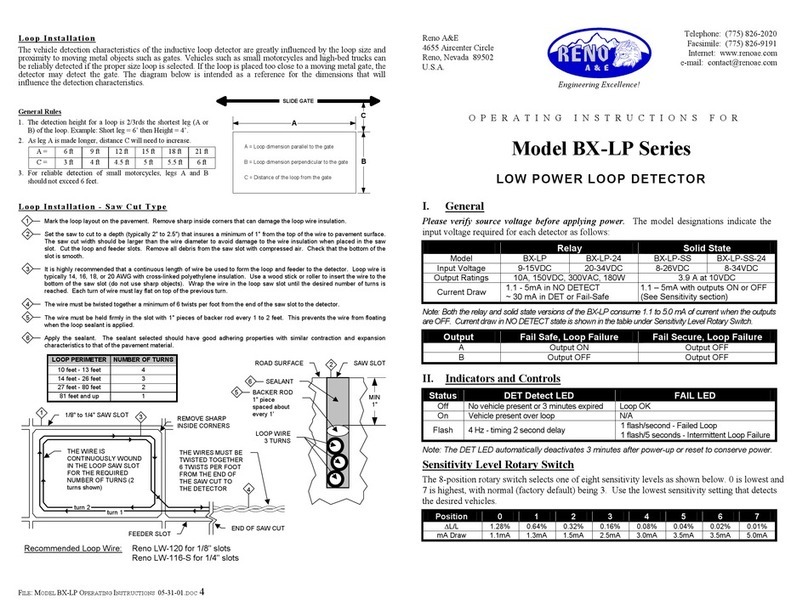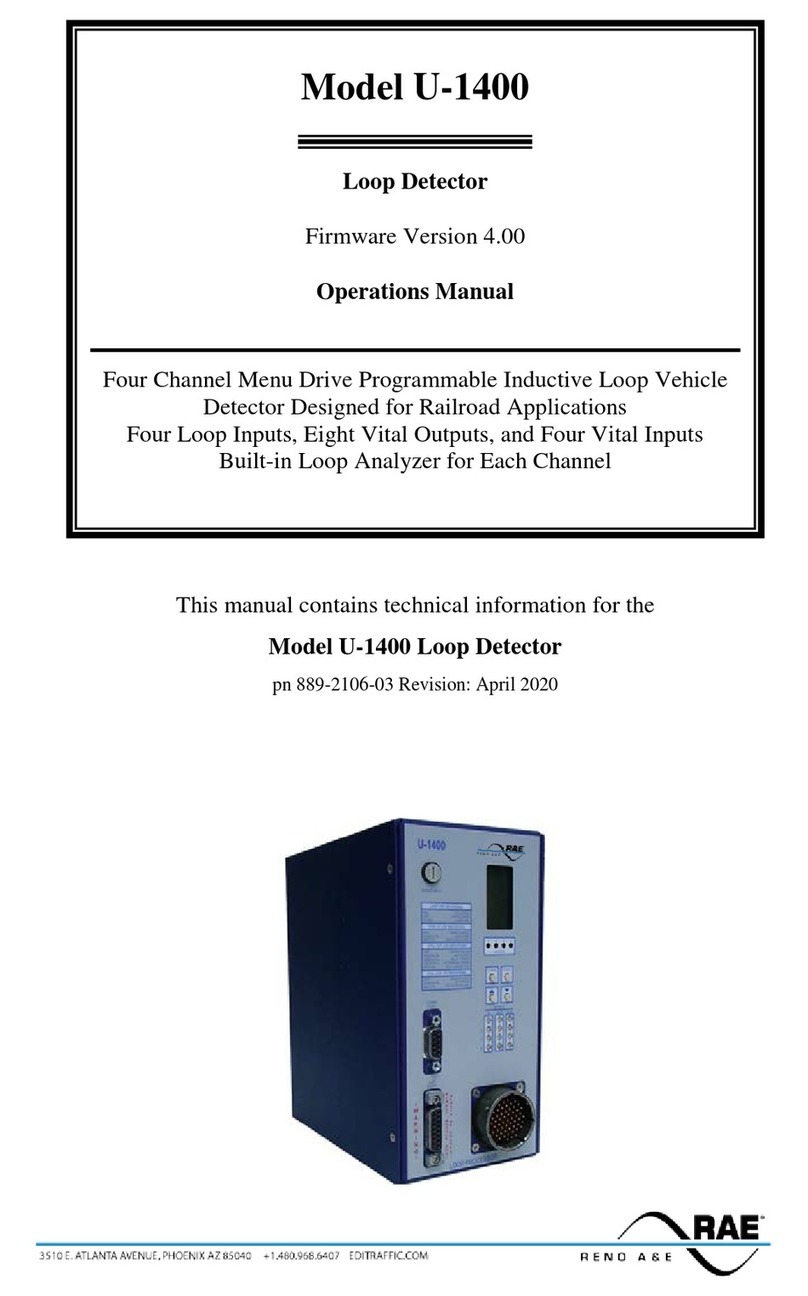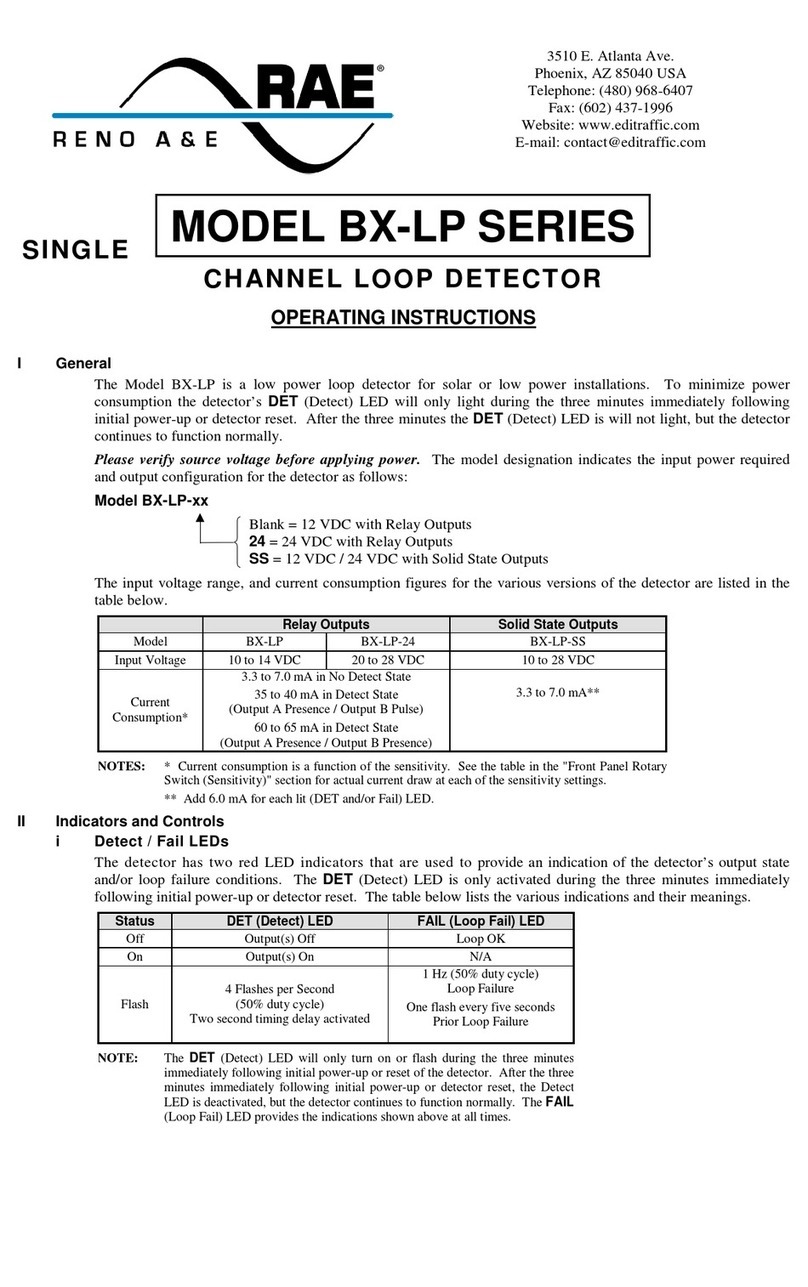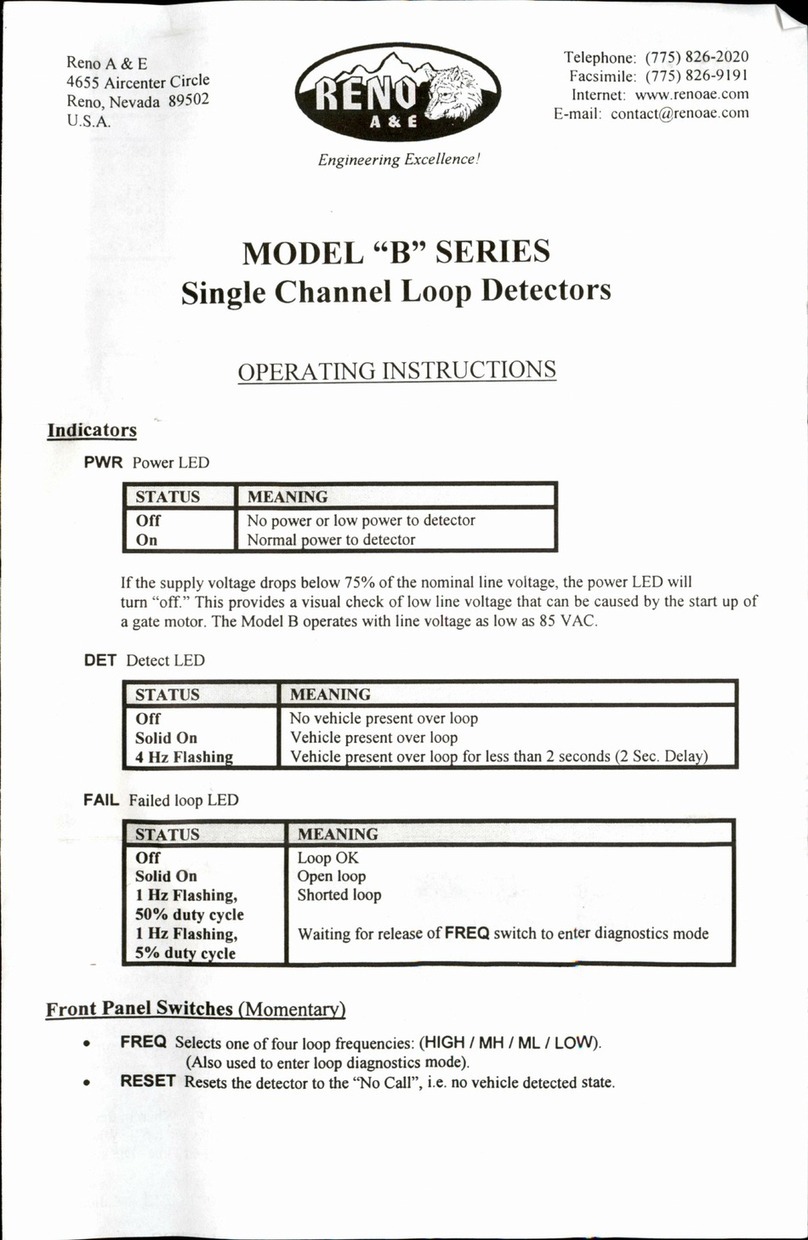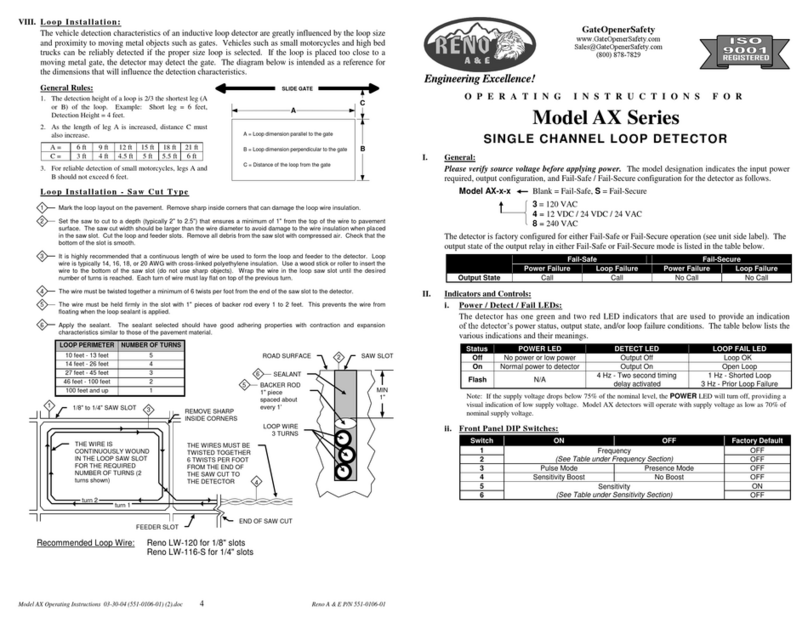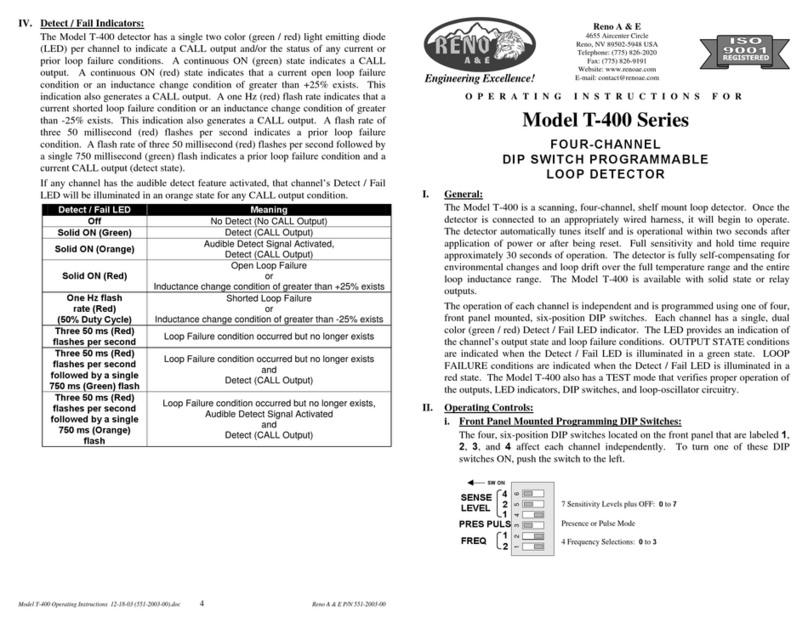
Model S-1212 Operating Instructions P/N 889-1910-00
2
Sensitivity Level
The Sensitivity Level can be adjusted from 1to 9or set to CALL or OFF. Press the
(UP) or
(DOWN) pushbutton to change the
programmed Sensitivity Level. The lowest Sensitivity Level is 1 and the highest Sensitivity Level is 9. Each detector channel can be
configured to place a permanent call by selecting CALL (one setting above Sensitivity Level 9). The detector channel can be disabled
by selecting OFF (one setting below Sensitivity Level 1). If CALL or OFF is selected, the LCD flashes the message CALL or OFF
during Normal display mode. Refer to Section IV Sensitivity Setting for instructions on how to use the bargraph to determine
the proper Sensitivity Level setting for the loop / lead-in network connected to the detector channel. The factory default setting is
Sensitivity Level 4 for both channels. NOTE: Changing the Sensitivity Level setting will reset the detector channel. The
Sensitivity Level setting should not be changed while the detection zone is occupied.
Presence / Pulse Mode
Pressing either the
(UP) or
(DOWN) pushbutton toggles between Presence and Pulse modes. Presence Mode provides a Call
hold time of at least four minutes (regardless of vehicle size) and typically one to three hours for an automobile or truck. When
operating in Pulse Mode, an output pulse of 125 ±10 milliseconds duration is generated for each vehicle entering the loop detection
zone. Each detected vehicle is instantly tuned out if it remains in the loop detection zone longer than two seconds. This enables
detection of subsequent vehicles entering the loop detection zone. After each vehicle leaves the loop detection zone, the detector
channel resumes full sensitivity within 0.5 seconds.
Call Extension, Call Delay, and Max Presence can all modify the operation of Presence Mode. Only Call Extension and Call Delay
modify Pulse Mode operation. The factorydefault setting of this Presence / Pulse Mode is OFF (Presence Mode) for both channels.
Call Delay Time
Call Delay Time can be adjusted from 0 to 255 seconds by pressing the (UP) or (DOWN) pushbutton. When the Call Delay
Time is set to 0 seconds, pressing the DOWN pushbutton steps the value up to 255 seconds. When the Call Delay Time is set to 255
seconds, pressing the UP pushbutton steps the value down to 0 seconds. During the Call Delay period, the Detect / Fail LED flashes
at a four Hz rate with a 50% duty cycle, the LCD displays a countdown of the Call Delay Time, and the output remains inactive.
When a vehicle enters the detection zone, the delay begins to count down. At the end of the delay time, the output activates and the
LED turns on. The factory default setting of Call Delay Time is 0 seconds for both channels.
Call Extension Time
Call Extension Time can be adjusted from 0 to 25.5 seconds by pressing the
(UP) or
(DOWN) pushbutton. When the Call
Extension Time is set to 0 seconds, pressing the DOWN pushbutton steps the value up to 25.5 seconds. When the Call Extension
Time is set to 25.5 seconds, pressing the UP pushbutton steps the value down to 0. During the Call Extension period, the Detect / Fail
LED flashes at a 16 Hz rate with a 50% duty cycle and the LCD displays a countdown of the Call Extension Time. When a vehicle
leaves the detection zone, the output remains active until the extension time reaches 0. The factory default setting of Call Extension
Time is 0.0 seconds for both channels.
Max Presence Time
Max Presence Time can be adjusted from OFF to 999 seconds by pressing the
(UP) or
(DOWN) pushbutton. When Max
Presence time is set to OFF, pressing the
(DOWN) pushbutton steps the value to 999 seconds.
A Call output occurs either when a vehicle is detected (Delay Time = 0) or after the delay timer has counted down to zero following
the arrival of a vehicle. The Max Presence timer starts timing when a Call output occurs. Any time a Call output drops while the Max
Presence timer is timing, the Max Presence timer is reset to the Max Presence time setting. The Max Presence timer counts towards
zero as long as the Call output exists. When the Max Presence timer reaches zero, the detector is reset. The factory default setting of
Max Presence Time is OFF for both channels. NOTE: If the Max Presence timer does reset the detector, no Call Extension time
will occur.
End-of-Green (EOG)
Pressing either the (UP) or (DOWN) pushbutton toggles between ON and OFF. See Max Presence Time above for the effects
of turning this feature on. The factory default setting of End-of-Green is OFF for both channels. NOTE: The End-of-Green screen
is visible only if Max Presence Time is not set to OFF.
Option 1 - Display Loop Inductance (L)
Pressing either the
(UP) or
(DOWN) pushbutton toggles Option 1 between ON and OFF. When Option 1 is OFF, the LCD
indicates three dashed lines (- - -) during a No Call state or CALL and the Call strength (via the LCD bargraph display) during a Call
state. When Option 1 is ON and the detector is operating in Normal display mode, the LCD continuously indicates the Loop
Inductance value (L) in microhenries (μH) between 15 and 2500 μH. The display shows three digits if the inductance is between 15
and 999 μH. If the inductance is greater than 999 μH, the display alternately flashes between 1or 2and the lower three digits. The
combination of the one and three digit displays represent inductance values from 1000 to 2500 μH. When a vehicle is detected, the
Call is indicated by means of the Detect / Fail LED and the LCD bargraph display. The countdown of the Delay, Extension, and/or
Max Presence timers is not displayed when Option 1 is ON. Once activated, Option 1 will automatically turn off after five (5)
minutes have elapsed. The factory default setting of Option 1 is OFF for both channels.
Option 2 - Display % Loop Inductance Change (-
L/L)
Pressing either the
(UP) or
(DOWN) pushbutton toggles Option 2 between ON and OFF. When Option 2 is OFF, the LCD
indicates a Call when a vehicle is detected. When Option 2 is ON, the LCD indicates the -ΔL/L value when a vehicle is detected. The
maximum -ΔL/L that occurred is displayed for two seconds unless a greater change occurs. Once activated, Option 2 will
automatically turn off after five (5) minutes have elapsed. The factory default setting of Option 2 is OFF for both channels.
Option 3 - Call Extension Control
Pressing either the (UP) or (DOWN) pushbutton toggles between ON and OFF. When Option 3 is OFF, the detector extends
all calls for the programmed extension time. When Option 3 is ON, the detector extends calls for the programmed extension time only
when the associated Phase Green Input (Delay Override) signal is active. The factory default setting of Option 3 is OFF for both
channels.
Option 4 - Noise Filter Disable
Pressing either the
(UP) or
(DOWN) pushbutton toggles between ON and OFF. When Option 4 is OFF, internal noise filtering
is utilized. When Option 4 is ON, internal noise filtering is disabled thus providing a faster response time. Changing the setting of
this option will reset both detector channels. It is recommended that this option only be turned ON when the detector is used for
speed and/or occupancy measurement applications. The factory default setting of Option 4 is OFF for both channels. NOTE:
Turning this option ON for either channel turns it ON for both channels.
